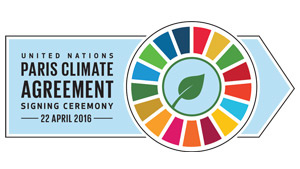
The Paris Agreement is the first-ever universal, legally binding global climate deal that aims at “strengthening the global response to the threat of climate change, in the context of sustainable development and efforts to eradicate poverty”. Article 2 of the Agreement sets for the first time a “Degree Celsius” target of “[h]olding the increase in the global average temperature to well below 2°C”, while pursuing efforts to limit the increase to 1.5°C in order to “significantly reduce the risks and impacts of climate change”. The temperature of the Earth has already warmed at least 1°C[1] and the effects of the climate system are already impacting both inhabitants and the natural environment. This is exemplified by rising sea levels and floods as well as an increase in droughts and hurricanes.
The agreement sets the means to achieve its ambitious goals by requiring all Parties to put forward intended nationally determined contributions (INDCs). INDCs are national climate actions aimed at reducing greenhouse emissions where countries determine the measures and the kind of support they need or will provide in order to address climate change. The State of Palestine is now in the process of preparing its INDC to be submitted to the Secretary-General.
Although climate change affects everyone, it is the poor and disadvantaged that disproportionally suffer. The effects of climate change may be felt more severely in developing countries, whose carbon footprint is limited. As a result, many of these countries are not able to easily cope with the impacts and risk losing their livelihoods. The Paris Agreement recognizes such ‘climate injustice’ and emphasizes the environmental principle of ‘common but differentiated responsibility’. The Agreement provides that developed countries should take the lead by undertaking economy-wide absolute emission reduction targets and provide support for developing countries. Additionally, developed countries agreed to muster a floor of USD 100 billion per year up to 2025 to assist developing countries – although this was not included in the text of the Agreement.
In the context of the Occupied Palestinian Territory (OPT), the on-going Israeli occupation has caused extensive environmental harm while exploiting and appropriating its natural resources. Armed conflicts significantly harm the environment and communities dependent on natural resources , leading to human exploitation, structural inequality and marginalization among other impacts. Although the UNFCCC, and the Paris Agreement, do not include any specific provisions on the interaction between climate change and conflict, there is recognition of this connection. Climate change can increase the vulnerability of populations experiencing armed conflict, as communities will have to survive armed conflict and climate change simultaneously. This may protract the conflict while making it increasingly challenging for affected communities to sustainably survive.
Armed conflict can contribute to climate change through the conduct of hostilities, for example the employment of certain high-tech weaponry can contribute to increased CO2 emissions. The 2014 Israeli Offensive on the Gaza Strip has resulted in a variety of environmental impacts on water, soil and air, where Israel attacked the Gaza Power Plant, which supplies one third of energy needs in the Gaza Strip, as well as water pumps and wastewater treatment plants.
Armed conflict can also trigger climate change through the exploitation of natural resources or by causing extensive environmental damage. Natural resources are often considered the “wealth of the poor”, as local communities often rely on such resources to sustain their livelihoods. However, the destruction of natural resources is known to be a driver for poverty, forced migration and may also trigger local conflict. In the context of the OPT, Israel has been unlawfully exploiting water, agricultural land, Dead Sea minerals, stone, and the natural gas of the protected Palestinian civilians. Such exploitation and appropriation is part of systematic environmental injustice due to Israel’s colonial occupation.
The Israeli occupation is imposing serious challenges to environmental security and hindering the ability of Palestinian communities to adapt to climate change. Despite such challenges, in 2010 the Palestinian Authority developed a “Climate Change Adaptation Strategy and Programme of Action”. The strategy identified water as the priority focus of climate change impacts and recognized agriculture as the most sensitive sector of the Palestinian economy to the effects of climate change. In total, the strategy focused on reducing both water and food insecurity. Massafer Yatta (in southern Hebron), the Jordan Valley and the Gaza Strip were identified in the strategy as the three top areas having the highest levels of climate vulnerability.
The Strategy also recognized that certain historic forms of individual and community coping by Palestinians in the face of climate change offer potential avenues for a broader adaptation strategy in the OPT. However, the ongoing Israeli occupation undermines the political and economic conditions necessary for their operation and fosters “maladaptive policies” such as the destruction of Palestinian olives groves.
The strategy acknowledged the “need for climate modeling and research capacity-building in the [OPT] tailored to Palestinian adaptation priorities in the face of future climate risks”, despite the “significant uncertainties about the precise impacts of climate change in the region”. The strategy identified disaster risk reduction (DRR) as the first line of institutional defense against serious climate change impacts. DRR is the development and implementation of policies and practices that minimize the risks from having disasters. It also included “no-regrets” and “low-regrets” adaptive measures, such as the introduction of more efficient irrigation techniques and the increase use of water harvesting. Such low cost adaptation measures have been recognized to have the highest levels of adaptive capacity and technical feasibility against climate change risks. The strategy also considered high cost adaptation measures, such as the development of new water sources. Such measures might be considered by donors and can be part of human and economic development projects.
Although the UNFCCC does not include any provisions concerning specific assistance or protection for those who will be directly affected by climate change in general or those who are caught in an armed conflict or are under occupation, certain measures might assist in climate change mitigation. Israel must respect and undertake its duties under international humanitarian law, which protects both civilians as well as the natural environment. Moreover, humanitarian and development responses to vulnerable communities within the OPT will need to “increasingly focus on supporting people’s resilience”, by providing “sustainable improvements in people’s lives”, that focus on their livelihoods, natural resources, social networks, basic services and infrastructure which help people endure the impacts of armed conflict and adapt to climate risks.
In light of such vulnerabilities and challenges to combating climate change, Al-Haq welcomes the signing of the Paris Agreement by the State of Palestine and perceives such a step as part of continuing effort to protect the environment in the OPT. Al-Haq further underlines and calls on Israel to respect its obligations under international human rights and humanitarian law, including those related to environmental justice, arising from its status as the occupying power. In December 2014, Palestine also acceded to three main environmental treaties, the Basel Convention on the Control of Transboundary Movements of Hazardous Wastes and their Disposal; the Convention on Biological Diversity and the Cartagena Protocol on Biosafety to the Convention on Biological Diversity; and the United Nations Convention on the Law of the Sea, which will all provide avenues for pursuing environmental justice in the face of the Israeli occupation.
[1] According to the UN’s Intergovernmental Panel on Climate Change (IPCC), there was a warming of 0.85 [0.65 to 1.06] °C of the Earth surface over the period from 1880 to 2012.


